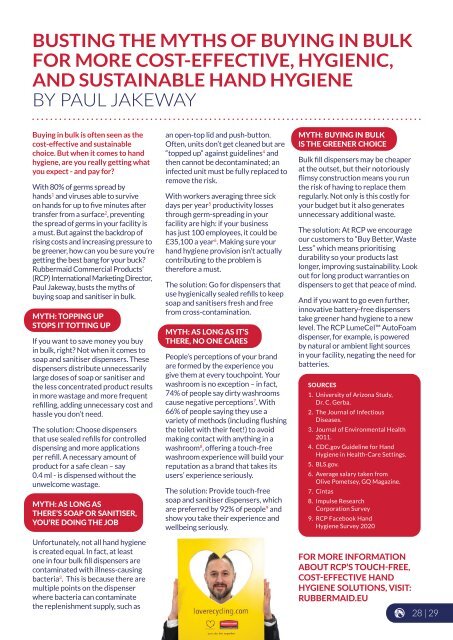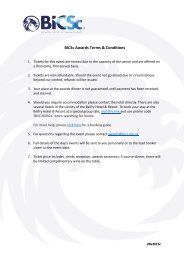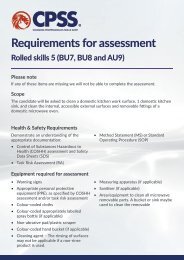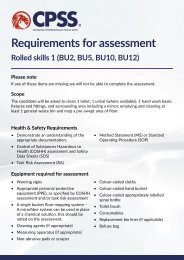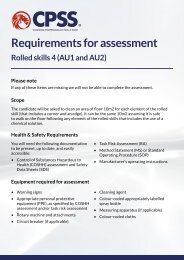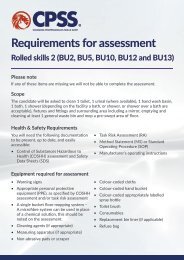The Standard Issue 4 2022
Create successful ePaper yourself
Turn your PDF publications into a flip-book with our unique Google optimized e-Paper software.
BUSTING THE MYTHS OF BUYING IN BULK<br />
FOR MORE COST-EFFECTIVE, HYGIENIC,<br />
AND SUSTAINABLE HAND HYGIENE<br />
BY PAUL JAKEWAY<br />
Buying in bulk is often seen as the<br />
cost-effective and sustainable<br />
choice. But when it comes to hand<br />
hygiene, are you really getting what<br />
you expect - and pay for?<br />
With 80% of germs spread by<br />
hands 1 and viruses able to survive<br />
on hands for up to five minutes after<br />
transfer from a surface 2 , preventing<br />
the spread of germs in your facility is<br />
a must. But against the backdrop of<br />
rising costs and increasing pressure to<br />
be greener, how can you be sure you’re<br />
getting the best bang for your buck?<br />
Rubbermaid Commercial Products’<br />
(RCP) International Marketing Director,<br />
Paul Jakeway, busts the myths of<br />
buying soap and sanitiser in bulk.<br />
MYTH: TOPPING UP<br />
STOPS IT TOTTING UP<br />
If you want to save money you buy<br />
in bulk, right? Not when it comes to<br />
soap and sanitiser dispensers. <strong>The</strong>se<br />
dispensers distribute unnecessarily<br />
large doses of soap or sanitiser and<br />
the less concentrated product results<br />
in more wastage and more frequent<br />
refilling, adding unnecessary cost and<br />
hassle you don’t need.<br />
<strong>The</strong> solution: Choose dispensers<br />
that use sealed refills for controlled<br />
dispensing and more applications<br />
per refill. A necessary amount of<br />
product for a safe clean – say<br />
0.4 ml - is dispensed without the<br />
unwelcome wastage.<br />
MYTH: AS LONG AS<br />
THERE’S SOAP OR SANITISER,<br />
YOU’RE DOING THE JOB<br />
Unfortunately, not all hand hygiene<br />
is created equal. In fact, at least<br />
one in four bulk fill dispensers are<br />
contaminated with illness-causing<br />
bacteria 3 . This is because there are<br />
multiple points on the dispenser<br />
where bacteria can contaminate<br />
the replenishment supply, such as<br />
an open-top lid and push-button.<br />
Often, units don’t get cleaned but are<br />
“topped up” against guidelines 4 and<br />
then cannot be decontaminated; an<br />
infected unit must be fully replaced to<br />
remove the risk.<br />
With workers averaging three sick<br />
days per year 5 productivity losses<br />
through germ-spreading in your<br />
facility are high: if your business<br />
has just 100 employees, it could be<br />
£35,100 a year 6 . Making sure your<br />
hand hygiene provision isn’t actually<br />
contributing to the problem is<br />
therefore a must.<br />
<strong>The</strong> solution: Go for dispensers that<br />
use hygienically sealed refills to keep<br />
soap and sanitisers fresh and free<br />
from cross-contamination.<br />
MYTH: AS LONG AS IT’S<br />
THERE, NO ONE CARES<br />
People’s perceptions of your brand<br />
are formed by the experience you<br />
give them at every touchpoint. Your<br />
washroom is no exception – in fact,<br />
74% of people say dirty washrooms<br />
cause negative perceptions 7 . With<br />
66% of people saying they use a<br />
variety of methods (including flushing<br />
the toilet with their feet!) to avoid<br />
making contact with anything in a<br />
washroom 8 , offering a touch-free<br />
washroom experience will build your<br />
reputation as a brand that takes its<br />
users’ experience seriously.<br />
<strong>The</strong> solution: Provide touch-free<br />
soap and sanitiser dispensers, which<br />
are preferred by 92% of people 9 and<br />
show you take their experience and<br />
wellbeing seriously.<br />
MYTH: BUYING IN BULK<br />
IS THE GREENER CHOICE<br />
Bulk fill dispensers may be cheaper<br />
at the outset, but their notoriously<br />
flimsy construction means you run<br />
the risk of having to replace them<br />
regularly. Not only is this costly for<br />
your budget but it also generates<br />
unnecessary additional waste.<br />
<strong>The</strong> solution: At RCP we encourage<br />
our customers to “Buy Better, Waste<br />
Less” which means prioritising<br />
durability so your products last<br />
longer, improving sustainability. Look<br />
out for long product warranties on<br />
dispensers to get that peace of mind.<br />
And if you want to go even further,<br />
innovative battery-free dispensers<br />
take greener hand hygiene to a new<br />
level. <strong>The</strong> RCP LumeCel AutoFoam<br />
dispenser, for example, is powered<br />
by natural or ambient light sources<br />
in your facility, negating the need for<br />
batteries. <br />
SOURCES<br />
1. University of Arizona Study,<br />
Dr. C. Gerba.<br />
2. <strong>The</strong> Journal of Infectious<br />
Diseases.<br />
3. Journal of Environmental Health<br />
2011.<br />
4. CDC.gov Guideline for Hand<br />
Hygiene in Health-Care Settings.<br />
5. BLS.gov.<br />
6. Average salary taken from<br />
Olive Pometsey, GQ Magazine.<br />
7. Cintas<br />
8. Impulse Research<br />
Corporation Survey<br />
9. RCP Facebook Hand<br />
Hygiene Survey 2020<br />
FOR MORE INFORMATION<br />
ABOUT RCP’S TOUCH-FREE,<br />
COST-EFFECTIVE HAND<br />
HYGIENE SOLUTIONS, VISIT:<br />
RUBBERMAID.EU<br />
28 | 29


